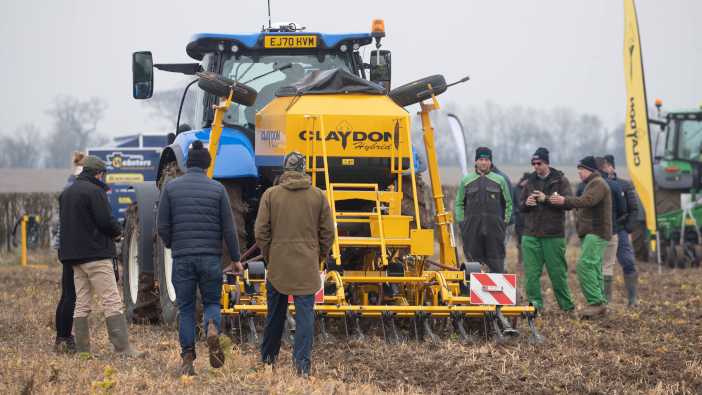There is no one-size-fits-all solution when considering which drill to buy but growers in Cheshire were given the opportunity to see a range of machines sowing wheat into a cover crop mix.
The Hutchinsons and CAS demonstration day, held near Runcorn with the kind permission of Stephen & Andrew Shaw was not supposed to find the best direct drill but instead provide a view on the performance of each machine and the impact on subsequent crop establishment.
The ten-hectare field, previously down as potatoes, was divided into one-hectare plots, each with three different cover crops established using a range of different systems.
Sown in August, the cover crop mixes used were:
- Maxi Cover – buckwheat, white mustard and berseem clover, designed for rapid growth
- Maxi Veg – linseed, buckwheat, phacelia and crimson clover
- Maxi Impact – sunflowers, linseed, buckwheat, phacelia, crimson clover and berseem clover
CAS agronomist Andrew Roberts was responsible for the trial and explained the reasoning behind it: “The high rainfall in the north-west is one of the biggest challenges to crop establishment and production. Up here we are looking at average rainfall of 900mm.
“It all comes down to being able to get onto the fields to drill in the autumn. So we are looking at how cover or catch crops might help to pull moisture out of the ground and help dry up soils to widen the drilling window.”
Mr Roberts added: “Wet weather prior to drilling on the open day, created some challenging conditions for all machines on the medium-bodied soil, but we got all the wheat drilled. Crop assessments and plant counts will be taken through the autumn and spring and the plots will be taken to harvest.”
| Drills demonstrated | Working width |
| Kverneland Udrill | 6m |
| Weaving GD | 6m |
| Horsch Avatar | 6m |
| Sky Agriculture Easydrill | 6m |
| Claydon Hybrid (with discs) | 3m |
| Mzuri Protill | 3m |
S & A Shaw – farm details
The farm comprises 364 hectares, with soils ranging from sandy loam to silty clay, and cropping of wheat, barley, oats and oilseed rape, with another 120 hectares of owned and rented land down as potatoes.
Mr Shaw is always looking at improving efficiency, which has proved especially important this year. “Costs are up and it’s been a challenging year for yields as a result of the dry spring and subsequent crop stress. Whilst these are issues beyond our control, there are areas that we can control in terms of improving soil health and cutting back on inputs.”
Three years ago, the farm began using Hutchinsons’ Omnia digital farming platform. Andrew Roberts worked with the family to introduce the system and incorporate as much data as possible.
He explained: “One of the first things we did was to have all of the fields scanned using Terramap. Previously, standard core samples were taken and on the back of the results from this, we would expect to apply potash and occasionally lime.”
“TerraMap allowed us to build up much more accurate data on the soils and has allowed us to create accurate variable rate drilling maps,” said Mr Roberts.
“In doing so, we have been variably applying potash and lime and this spring we plan to use NDVI biomass maps to vary nitrogen content and scale back on liquid fertiliser use and target applications, particularly across milling wheat varieties.
“It has meant that the sprayer has been updated, but this was a cost that was on the cards anyway.
“We are really pleased with Omnia and TerraMap as adopting this technology has helped us to ensure we are more efficient with our inputs without compromising output.”


